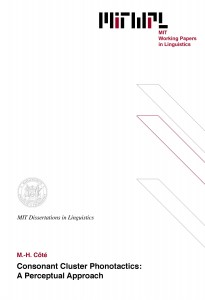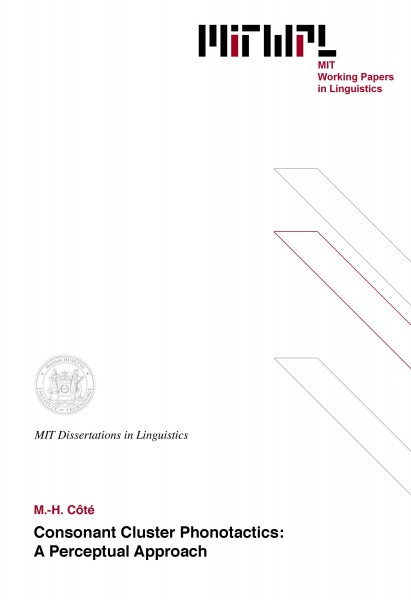Consonant Cluster Phonotactics: A Perceptual Approach
M.-H. Côté, 2000
This dissertation deals with deletion and epenthesis processes conditioned or constrained by the consonantal environment, essentially consonant deletion, vowel epenthesis, and vowel deletion. It is argues that the standard generative approach to these processes, which relies on the syllable and the principle of prosodic licensing, is empirically inadequate, and an alternative sequential approach based on perceptual factors is developed. It is proposed that the likelihood that a consonant deletes, triggers epenthesis, or blocks vowel deletion correlates with the quality and quantity of auditory cues associated to it in a given context. The approach is implemented in Optimality Theory and adopts more specifically the ‘Licensing by cue’ framework developed by Steriade (1999a,c).
New empirical generalizations concerning deletion and epenthesis processes are incovered, in particular 1) the fact that stops are more likely than other consonants to delete, trigger epenthesis, or block deletion; 2) the role of syntagmatic contrast in deletion and epenthesis processes; 3) the role of the audibility of stop release bursts; 4) the existence of cumulative edge effects, whereby more and more phonotactic combinations are licensed at the edges of prosodic domains as we go up the prosodic hierarchy. These generalizations are elucidated in terms of internal and contextual cues, modulation in the acoustic signal, and cue enhancement processes at edges of prosodic domains.
The proposed perceptual approach achieves a substantial simplification and unification of the conceptual apparatus necessary to analyze deletion and epenthesis processes. It subsumes under the more general notion of perceptual salience principles of well-formedness and the Obligatory Contour Principle. Furthermore, it eliminates the need for exceptional mechanisms such as extrasyllabicity at domain edges.
The analysis is based on the study of deletion and epenthesis processes in a variety of languages. Detailed investigations of schwa in Parisian French, cluster simplification in Quebec French, and stop deletion and vowel epenthesis in Ondarroa Basque are provided.
Thesis Supervisor: Michael Kenstowicz
Title: Professor of Linguistics
<br/>
Table of Contents
Introduction 9
Chapter 1 Against the Syllabic Approach to Deletion and Epenthesis 13
1.1 The syllabic approach: elements 14
1.1.1 From SPE to Prosodic Phonology 14
1.1.2 Syllable well-formedness conditions 16
1.1.2.1 Syllable templates 18
1.1.2.2 Coda Conditions 19
1.1.2.3 The Sonority Sequencing Principle 21
1.2 The syllabic approach: weaknesses 22
1.2.1 It is insufficient: extrasyllabicity and sequential constraints 23
1.2.1.1 Extrasyllabicity 24
1.2.1.2 Sequential constraints 26
1.2.2 It is unnecessary: equivalent sequential analyses 31
1.2.3 It is inadequate: a review of some syllabic analyses 38
1.2.3.1 Hungarian cluster simplification and degemination 38
1.2.3.2 Attic Greek coronal stop deletion 47
1.2.3.3 English final coronal stop deletion 56
1.2.3.4 Icelandic consonant deletion 61
1.3 Conclusions 74
Appendix: Preterit forms of Icelandic weak verbs 76
Chapter 2 Schwa deletion and epenthesis in French 79
2.1 Basic facts 80
2.1.1 The underlying status of schwa 80
2.1.2 The distribution of schwa across contexts 82
2.2 Syllabic accounts 87
2.2.1 Pulgram (1961) 88
2.2.2 Subsequent analyses 90
2.2.2.1 Step 1: the most restrictive approach 91
2.2.2.2 Step 2: allowing for extrasyllabicity 94
2.2.2.3 Problematic cases: clitics and morpheme-internal
schwas 98
2.2.3 Schwa and variability 101
2.2.4 A flexible approach to syllable well-formedness? 105
2.3 Sequential generalizations 107
2.3.1 Adjacency to vowels 107
2.3.2 The Sonority Sequencing Principle 112
2.3.3 The special status of stops 119
2.3.4 Stops followed by a [-continuant] segment 122
2.3.5 Similarity to adjacent consonants 123
2.3.5.1 Contrast in [vocoid] 124
2.3.5.2 Agreement in [+vocoid] 126
2.3.6 Prosodic boundaries 129
2.4 Conclusions 133
Chapter 3 Basic Theoretical Elements and Their Perceptual Motivations 135
3.1 Perceptual motivations 137
3.1.1 CV and VC transitions 138
3.1.2 Internal cues and the greater vulnerability of stops 140
3.1.3 The audibility of release bursts 142
3.1.4 Contrast and modulation in the acoustic signal 143
3.1.5 Cue enhancement at edges of prosodic domains 146
3.1.6 Coronal stops and F2 transitions 151
3.2 Theoretical apparatus 152
3.2.1 Perception in phonological theory 153
3.2.2 Markedness constraints 157
3.2.3 Faithfulness constraints 163
3.2.4 Limiting the role of phonetic grounding 179
3.2.5 Variation in Optimality Theory 181
3.3 Applications 183
3.3.1 Lenakel vowel epenthesis 183
3.3.2 Sranan consonant deletion 189
3.4 Conclusions 192
Appendix: Additional patterns showing the special status of stops 193
Chapter 4 Contrast 197
4.1 The proposed approach to contrast between adjacent segments 198
4.1.1 Review of the constraint system 198
4.1.2 Comparisons with other approaches to syntagmatic contrast 200
4.1.2.1 Early proposals 201
4.1.2.2 The Obligatory Contour Principle 202
4.2 Identity avoidance: first applications 211
4.2.1 Agreement in [place]: Catalan 211
4.2.2 Agreement in [voice]: Black English 216
4.2.3 Agreement in [+vocoid]: French 217
4.2.4 Interaction of manner and place: Hungarian and Siatista
Greek 221
4.3 Cluster simplification in Quebec French 227
4.3.1 Attested final clusters and previous analyses 227
4.3.2 Cluster reduction and sonority 232
4.3.2.1 Obstruent-approximant clusters 233
4.3.2.2 Obstruent-nasal clusters 235
4.3.2.3 Nasal-approximant clusters 236
4.3.2.4 Analysis 237
4.3.3 Cluster reduction and perceptual salience 239
4.3.3.1 Data 240
4.3.3.2 Analysis 253
4.3.3.3 A similar pattern: Philadelphia English 264
4.4 Conclusions 265
Chapter 5 Edge Effects 267
5.1 Introduction 267
5.2 Expanding the empirical basis of edge effects 270
5.3 First case studies 274
5.3.1 Epenthesis in Cairene and Iraqi Arabic 275
5.3.2 Epenthesis in French 278
5.3.3 Stop deletion in Marais-Vendeen 282
5.3.4 Epenthesis in Vimeu Picard 284
5.4 Epenthesis and deletion in Basque 289
5.4.1 (Ondarroa) Basque: some basic facts 289
5.4.2 Stops and affricates in prevocalic position 293
5.4.3 Deletion in closed-category lexical items 295
5.4.3.1 IP-internal deletion 295
5.4.3.2 IP-final retention 298
5.4.4 Epenthesis and simplification in nouns/adjectives 299
5.4.4.1 Excursus on the inflectional system 300
5.4.4.2 PW-internal contexts 302
5.4.4.3 PW-final, IP-internal contexts 307
5.4.4.4 IP-final contexts 309
5.4.5 Summary 310
5.4.6 Analysis of edge effects in Ondarroa Basque 312
5.4.7 Cross-dialectical comparisons and the OCP approach 322
5.5 Conclusions 328
References 331

